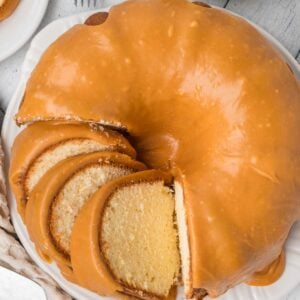5-Star Southern Caramel Bundt Cake
This caramel bundt cake is my favorite thing to take to a church supper or any potluck at all. This is better than a traditional caramel cake because layers are annoying and pouring icing on top is fun. The icing is pretty much like making actual caramel candy and then turning it into a spreadable frosting. Not hard, just different.

You can beat the icing just a little and have pourable glaze, or you can beat it longer to have more of a piping consistency. Either way, as the icing dries, it will harden because of all the sugar.
Ingredients and Tools You’ll Need
Most discount grocery stores do not carry cake flour regularly. No worries! I’ve provided a substitute below. Make sure you have a candy thermometer (I’ve linked mine down below). It’s crucial for getting the caramel just right.

Equipment
- Bundt pan (10-12 cup capacity)
- Electric Mixer (handheld or stand mixer)
- Large mixing bowls
- Medium saucepan (at least 3 quarts)
- Small heavy-bottomed saucepan (important for not burning the sugar)
- Whisk
- Rubber spatula or wooden spoon
- Wire cooling rack
- Candy thermometer (important for getting the icing just right)
Ingredients
For the Cake:
- 1 cup butter (softened 2 sticks)
- 2 cups white sugar
- 4 eggs (room temperature)
- ½ cup milk
- ½ cup sour cream
- 1 teaspoon vanilla extract
- 3 cups cake flour (If you don’t have it, mix 2 ¾ cups plus 1 tablespoon of regular flour with 3 tablespoons of cornstarch.)
- 2 teaspoons baking powder
- ¾ teaspoon salt
For the Icing:
- ⅓ cup white sugar (to caramelize)
- 1¼ cup milk
- 1 teaspoon flour
- 2 ½ cups white sugar (to add to the milk)
- ¾ cup butter
- 1 teaspoon vanilla extract
Heart’s Content Farmhouse is a participant in the Amazon Services LLC Associates Program, an affiliate advertising program designed to provide a means for sites to earn advertising fees by advertising and linking to Amazon.com. This means that when you click on certain links on this site and make a purchase, I may earn a small commission at no additional cost to you. I only recommend products I genuinely believe in and would use in my own kitchen. As an Amazon Associate, I earn from qualifying purchases.
A Newsletter you’ll love
Daily recipes from the farmhouse, Sunday meal plans, seasonal ideas, straight from my kitchen to your inbox.
I promise to keep your email address safe. Unsubscribe at any time
How to Make Caramel Bundt Cake
Making caramel can be tough when it’s humid out because the extra moisture in the air messes with the texture. It’s best to try making your cake on a day that’s not so humid for the best caramel.
To make the cake:
Step One: Preheat And Prepare The Pan
Preheat your oven to 350°F (175°C) and position the oven rack in the center. Then, grease a Bundt pan with shortening or butter and dust with flour, or use a baking spray that contains flour.
Be careful and very thorough when you’re greasing the Bundt pan. These pans have many detailed shapes, so you need to get every small spot covered with butter and flour or use a baking spray with flour.

Step Two: Blend The Wet Ingredients
In a large bowl, beat the softened butter with an electric mixer until light and fluffy, about 2-3 minutes. Slowly add the sugar and continue beating until creamy. Then, add the eggs one at a time, beating well after each addition. Mix in the sour cream and vanilla extract until fully combined.

Step Three: Mix Dry Ingredients
Whisk together the cake flour, baking powder, and salt in a separate bowl.

Step Four: Combine
Slowly add the dry ingredients to the butter mixture, alternating with the milk. Start and end with the dry ingredients. Mix until just combined, being careful not to overmix.

Step Five: Bake The Cake
Pour the batter into the prepared Bundt pan and smooth the top. Bake for 50-65 minutes until a cake tester or toothpick inserted into the center comes clean.

Step Six: Cool The Cake
Let the cake cool in the pan for 5 minutes, then turn it onto a wire rack to cool completely before icing.

To make the icing:
Step One: Caramelize The Sugar
In a small, heavy-bottomed saucepan (at least 3 quarts), sprinkle ⅓ cup of granulated sugar evenly across the bottom. Cook over medium heat, stirring constantly, until the sugar melts and turns a light amber color. Be patient, as the sugar may clump before melting smoothly. Keep an eye on it, it will go from golden to burnt quickly.

Step Two: Prepare The Milk Mixture
Whisk together the milk, the remaining sugar, and 1 teaspoon of flour in a separate large saucepan. Heat the mixture over medium heat, stirring constantly, until it boils.

Step Three: Combine And Cook
Carefully pour the hot milk mixture into the caramelized sugar. Then, reduce the heat to low and stir until the sugar clumps dissolve completely. Next, raise the heat to medium and cook until the mixture thickens and reaches 238°F on a candy thermometer (soft-ball stage), about 5-10 minutes. Remove the pot from the heat and stir in the butter until melted. Let the mixture sit at room temperature for about 1 hour to cool.

Step Four: Beat The Icing Until Thickened
Once the caramel mixture has cooled to about 110°F, transfer it to a mixing bowl. Add the vanilla extract and beat with an electric mixer until the icing thickens to your desired consistency. For a thinner glaze, beat for 2-3 minutes. For a thicker consistency suitable for piping, beat for 5-7 minutes. I recommend taking a small amount and putting it on the cake to see how it sets before you pour it all on. I usually end up beating a few minutes more for a thicker texture.

Step Five: Ice The Cake
Once the cake is completely cool, drizzle or pour the caramel icing over the top. If you want, use thicker icing for piping decorative touches.

Storing & Serving Caramel Bundt Cake
Let it cool completely and wait for the icing to firm up before covering it and storing it at room temperature. It’s good for about 2 days like this. Use a container that seals well, or wrap it snugly in plastic to keep it fresh.
If you need to store it longer, put it in the fridge, well-wrapped or in a sealed container, for up to 5 days.
If you want to freeze it, don’t add any icing. First, wrap the cooled cake without icing in plastic, then again in foil, and put it in something freezer-safe. It will be kept in the freezer for up to 3 months.
Questions and Troubleshooting
It’s helpful but not a dealbreaker. If you don’t have one, you can use the “soft-ball stage” method: drop a little of the caramel into cold water, and if it forms a soft, pliable ball, it’s ready. Just keep a close eye on it!
Don’t worry, you can fix it! Just gently reheat the caramel over low heat and stir until it loosens again. Once it’s smooth and pourable, you can continue icing the cake.
You can, but keep in mind that the bake time might change. A 9×13 pan or two 9-inch round pans should work, but start checking for doneness a bit earlier.

More Bundt Cake Recipes
- With chocolate icing and sugared cranberries, everyone will love this chocolate Christmas Bundt cake.
- A coconut lemon Bundt cake would be lovely for a bridal shower.
- This blackberry Bundt cake is a simple summer favorite!
- Enjoy fresh peaches in this summertime peach Bundt cake.
Printable Recipe
Southern Caramel Bundt Cake

Equipment
- Bundt pan (10-12 cup capacity)
- Electric Mixer (handheld or stand mixer)
- Large mixing bowls
- Medium saucepan (at least 3 quarts)
- Small heavy-bottomed saucepan
- Whisk
- Rubber spatula or wooden spoon
- Wire cooling rack
- Candy thermometer (for icing)
Ingredients
For the Cake:
- 1 cup butter (softened 2 sticks)
- 2 cups white sugar
- 4 eggs (room temperature)
- ½ cup milk
- ½ cup sour cream
- 1 teaspoon vanilla extract
- 3 cups cake flour see notes
- 2 teaspoons baking powder
- ¾ teaspoon salt
For the Icing:
- ⅓ cup white sugar (to caramelize)
- 1¼ cup milk
- 1 teaspoon flour
- 2 ½ cups white sugar (to add to the milk)
- ¾ cup butter
- 1 teaspoon vanilla extract
Save This Recipe
You'll join my email list which you will love. And if you don't, unsubscribe in one click. ❤️
Instructions
To make the cake:
- Preheat and prepare the pan. Preheat your oven to 350°F (175°C) and position the oven rack in the center. Then, grease a Bundt pan with shortening or butter and dust with flour, or use a baking spray that contains flour.
- Blend the wet ingredients. In a large bowl, beat the softened butter with an electric mixer until light and fluffy, about 2-3 minutes. Slowly add the sugar and continue beating until creamy. Then, add the eggs one at a time, beating well after each addition. Mix in the sour cream and vanilla extract until fully combined.
- Mix dry ingredients. Whisk together the cake flour, baking powder, and salt in a separate bowl.
- Combine. Slowly add the dry ingredients to the butter mixture, alternating with the milk. Start and end with the dry ingredients. Mix until just combined, being careful not to overmix.
- Bake the cake. Pour the batter into the prepared Bundt pan and smooth the top. Bake for 50-65 minutes until a cake tester or toothpick inserted into the center comes clean.
- Cool the cake. Let the cake cool in the pan for 5 minutes, then turn it onto a wire rack to cool completely before icing.
To make the icing:
- Caramelize the sugar. In a small, heavy-bottomed saucepan (at least 3 quarts), sprinkle ⅓ cup of granulated sugar evenly across the bottom. Cook over medium heat, stirring constantly, until the sugar melts and turns a light amber color. Be patient, as the sugar may clump before melting smoothly. Keep an eye on it, it will go from golden to burnt quickly.
- Prepare the milk mixture. Whisk together the milk, the remaining sugar, and 1 teaspoon of flour in a separate large saucepan. Heat the mixture over medium heat, stirring constantly, until it boils.
- Combine and cook. Carefully pour the hot milk mixture into the caramelized sugar. Then, reduce the heat to low and stir until the sugar clumps dissolve completely. Next, raise the heat to medium and cook until the mixture thickens and reaches 238°F on a candy thermometer (soft-ball stage), about 5-10 minutes. Remove the pot from the heat and stir in the butter until melted. Let the mixture sit at room temperature for about 1 hour to cool.
- Beat the icing until thickened. Once the caramel mixture has cooled to about 110°F, transfer it to a mixing bowl. Add the vanilla extract and beat with an electric mixer until the icing thickens to your desired consistency. For a thinner glaze, beat for 2-3 minutes. For a thicker consistency suitable for piping, beat for 5-7 minutes. I recommend taking a small amount and putting in on the cake to see how it sets before you pour it all on. I usually end up beating a few minutes more for a thicker texture.
- Ice the cake. Once the cake is completely cool, drizzle or pour the caramel icing over the top. If you want, use thicker icing for piping decorative touches.
Notes
Nutrition
Love,











I love caramel and I love Bundt cakes! I will definitely try this! Such pretty cakes!